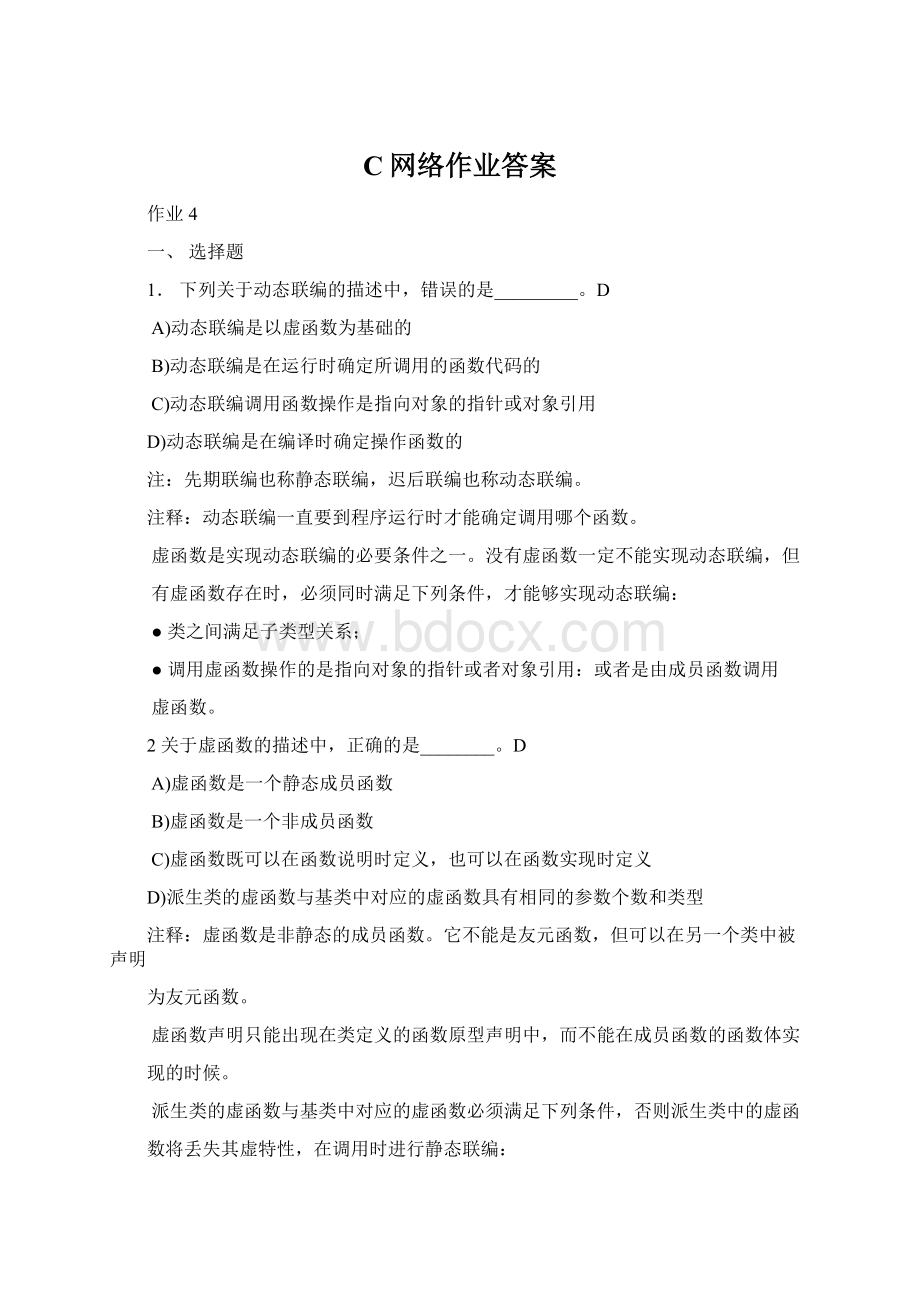C网络作业答案Word格式.docx
《C网络作业答案Word格式.docx》由会员分享,可在线阅读,更多相关《C网络作业答案Word格式.docx(16页珍藏版)》请在冰豆网上搜索。

virtua1<
函数返回类型>
<
函数名>
(<
参数表>
)
4对虚函数的调用________。
A)一定使用动态联编B)必须使用动态联编
C)一定使用静态联编D)不一定使用动态联编
参见第1题的注释。
5实现运行时的多态性要使用___________。
A)重载函数B)构造函数C)析构函数D)虚函数
6要实现动态联编,必须通过____调用虚函数。
A)对象指针B)成员名限定C)对象名D)派生类名
7在派生类中重新定义虚函数时,除了_____方面,其他方面都必须与基类中相应的
虚函数保持一致。
A)参数个数B)参数类型C)函数名称D)函数体
参见第2题的注释。
8下面关于构造函数和析构函数的描述,错误的是__。
A)析构函数中调用虚函数采用静态联编
B)对虚析构函数的调用可以采用动态联编
C)当基类的析构函数是虚函数时,其派生类的析构函数也一定是虚函数
D)构造函数可以声明为虚函数
构造函数不能声明为虚函数,但析构函数可以声明为虚函数。
当基类的析构函
数声明为虚函数时,无论派生类是否使用virtual关键字说明,派生类的析构函数一定
是虚函数,对缺省析构函数亦然。
而且,如果满足动态联编的其他条件,对虚析构函
数的调用将采用动态联编。
构造函数不能声明为虚函数,但在构造函数中可以调用虚函数。
在构造函数或析
构函数中调用虚函数,将采用静态联编。
9关于纯虚函数和抽象类的描述中,错误的是__。
C
A)纯虚函数是一种特殊的虚函数,它没有具体的实现
B)抽象类是指具有纯虚函数的类
C)一个基类中说明有纯虚函数,该基类的派生类一定不再是抽象类
D)抽象类只能作为基类来使用,其纯虚函数的实现由派生类给出
带有纯虚函数的类称为抽象类。
抽象类中的纯虚函数的实现由派生类给出:
但派生类仍可不给出纯虚函数的定义,继续作为抽象类存在。
10下列描述中,____是抽象类的特性。
A)可以说明虚函数B)可以进行构造函数重载
C)可以定义友元函数D)不能说明其对象
抽象类区别于其他类的最根本的特征是不能定义对象。
11_______是一个在基类中说明的虚函数,它在该基类中没有定义,但要求任何派生
类都必须定义自己的版本。
C
A)虚析构函数B)虚构造函数C)纯虚函数D)静态成员函数
12如果一个类至少有一个纯虚函数,那么就称该类为__。
A)抽象类B)虚基类C)派生类D)以上都不对
13以下___成员函数表示纯虚函数。
A)virtualintvf(int);
B)voidvf(int)=0;
C)virtualvoidvf()=0;
D)virtualvoidvf(int)()
纯虚函数的声明格式如下:
virtual<
)=0;
注意纯虚函数与虚函数体为空的区别。
纯虚函数根本就没有函数体,而空的虚
函数的函数体为空:
前者所在的类是抽象类,不能直接进行实例化,而后者所在的
类是可以实例化的:
14下面的描述中,正确的是_____。
A)virtual可以用来声明虚函数
B)含有纯虚函数的类是不可以用来创建对象的,因为它是虚基类
C)即使基类的构造函数没有参数,派生类也必须建立构造函数
D)静态数据成员可以通过成员初始化列表来初始化
virtual关键字既可以用来声明虚基类,也可以用来声明虚函数。
含有纯虚函数的类是抽象类,它不能用来定义对象。
静态数据成员的初始化必须在类体外进行。
如果所有的基类和子对象构造函数都不需要参数,派生类也不需要参数时,派
生类构造函数可以不定义。
15在下面程序中,A、B、C、D四句编译时不会出现错误的是__。
#include<
>
classBase
{
public:
Base(){}
Base(intc):
count(c){}
virtualvoidprint()const=0;
private:
intcount;
};
classDerived:
publicBase
public:
Derived():
Base(0){}
Derived(intc):
Base(c){}
voidprint()const{cout<
"
Derived"
endl;
}
voidmain()
Derivedd(10);
Base*pb;
pb=&
d;
Derive2'
sPrint()called.
根据结果将程序补充完整。
#include<
classBase
Base(inti){b=i;
}
___①virtualvoidPrint()=0;
___
protected:
intb;
classDerivel:
publicBase
{
___②Derive1(inti):
Base(i){}___
voidPrint()
{
cout<
”Derive1’sPrint()called.”<
}
classDerive2:
_③public:
Derive1(inti):
Base(i){}
voidPrint(){cout<
”Derive2’sPrint()called.“<
endl;
}_____
voidfun(_④Base*obj__)
obj->
Print();
_⑤Derive1*d1=newDerive1
(1);
_
Derive2*d2=newDerive2
(2);
fun(dl);
fun(d2);
注释:
派生类Derived1和Derived2从基类Base公有继承,它们是Base的子类型。
主程序中两次调用fun函数,该函数通过指针对象obj调用了Print函数,得到
了不同的输出结果。
而同样的消息被不同类型的对象接收时导致完全不同的行为,
恰好体现了面向对象的多态特性。
根据运行时的多态必须满足的条件,Print函数一
定是一个虚函数,并且在所有类中都必须进行定义。
由于Base类中的Print函数除
了提供一个公共的接口外,没有其他的作用,所以最好定义为纯虚函数。
12将下列程序补充完整。
classconvert
convert(doublei){vail=i;
_①virtualvoidcompute()=0;
doubleval1;
doubleval2;
};
<
voidfun(__④convert&
f_)
();
l_to_glgobj(4);
f_to_cfcobj(70);
fun(lgobj);
fun(fcobj);
13根据不同的输出结果,在函数Tone中填入正确的语句。
classInstrument
virtualvoidPrint()const{cout<
Instrument:
:
Print"
classPiano:
publicInstrument
voidPrint()const{cout<
Piano:
classGuitar:
voidPrint()const{cout<
Guitar:
voidTone(_____①_____)
___②_____
Guitarg;
Tone(g);
Pianop;
Tone(p);
(1)输出结果为:
:
Print
Instmment:
(2)输出结果为:
(1)①Instrumentobj②()
(2)①Instrument&
obj②()
参考第3题,第一次的输出是由静态联编产生的,第二次的输出是由动态态联编产生的。
14下列程序的运行结果如下:
Base'
scons.
Derived'
sdes.
Base(){cout<
scons."
_①virtual~Base()_{cout<
sdes."
Derived(){cout<
~Derived(){cout<
Base*ptr=_____②newDerived______
deleteptr;
三、编程
1.在作业1编程1的Point类中完成赋值运算符=、插入运算符<
、比较运算符==、!
=和加法运算符+、-的重载。
classPoint
{public:
Point(floatx=0,floaty=0,floatz=0):
x_(x),y_(y),z_(z){}
Point(constPoint&
p):
x_,y_,z_{}
3A6A9C11C12A13C14A15A16C2’“<
④Base*obj ⑤Derive1*d1=newDerive1
(1);
Derive2*d2=newDerive2
(2);
11①virtualvoidcompute()=0;
②l_to_g(doublei):
convert(i){}
③public:
f_to_c(doublei):
convert(i){}
voidcompute()
{
val2=(val1-32)*5/9;
cout<
val1<
”Fahrenheitis“<
val2<
”Celsius.”<
④convert&
f
13
14 ①virtual~Base() ②newDerived
1,
voidnegate(){x_*=-1;
y_*=-1;
z_*=-1;
doublenorm(){returnsqrt(x_*x_+y_*y_+z_*z_);
voidprint()
{cout<
'
('
x_<
"
"
y_<
z_<
)"
;
Point&
operator=(constPoint&
point);
boolPoint:
operator==(constPoint&
point)const
{returnx_==&
&
y_==&
z_==;
operator!
=(constPoint&
point)const
{returnx_!
=||y_!
=||z_!
=;
friendPointoperator+(constPoint&
p1,constPoint&
p2);
friendPointoperator-(constPoint&
friendostream&
operator<
(ostream&
ostr,constPoint&
private:
floatx_,y_,z_;
Pointoperator+(constPoint&
p2)
{returnPoint+,+,+;
Pointoperator-(constPoint&
{returnPoint&
point)
{returnostr<
("
Point&
Point:
operator=(constPoint&
{x_=;
y_=;
z_=;
return*this;
{Pointp(12,-3,4),q(14,5,12),r1,r2;
r1=p+q;
cout<
r1<
()<
r2=p-q+r1;
cout<
r2<
if(r1==r2)cout<
r1==r2"
elsecout<
r1!
=r2"
2,
Point(intx=0,inty=0,intz=0):
Point(constPoint&
operator++()
{x_++;
y_++;
z_++;
Pointoperator++(int)
{Pointtemp(*this);
x_++;
returntemp;
operator--()
{x_--;
y_--;
z_--;
Pointoperator--(int)
x_--;
intx_,y_,z_;
{Pointp(12,-3,4);
p="
();
Pointq(p++);
q="
++(++p);
p--;
3,
classShape
//Shape(){}
//~Shape(){}
virtualfloatGetArea(){return-1;
classCircle:
publicShape
Circle(floatradius):
itsRadius(radius){}
//~Circle(){}
floatGetArea(){return*itsRadius*itsRadius;
floatitsRadius;
classRectangle:
publicShape
Rectangle(floatlen,floatwidth):
itsLength(len),itsWidth(width){};
//~Rectangle(){};
floatGetArea(){returnitsLength*itsWidth;
floatGetLength(){returnitsLength;
floatGetWidth(){returnitsWidth;
floatitsWidth;
floatitsLength;
classSquare:
publicRectangle
Square(floatlen);
//~Square(){}
Square:
Square(floatlen):
Rectangle(len,len)
{}
Shape*sp;
sp=newCircle(5);
TheareaoftheCircleis"
sp->
GetArea()<
deletesp;
sp=newRectangle(4,6);
TheareaoftheRectangleis"
sp=newSquare(5);
TheareaoftheSquareis"
4,
virtualfloatGetArea()=0;
virtualfloatGetPerim()=0;
floatGetPerim(){return*itsRadius;
virtualfloatGetArea(){returnitsLength*itsWidth;
floatGetPerim(){return2*(itsLength+itsWidth);
ThePerimeteroftheCircleis"
GetPerim()<